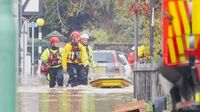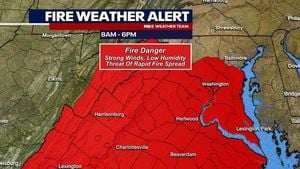On November 15 and 16, 2025, the tranquil Welsh town of Monmouth was transformed into a scene of chaos as Storm Claudia unleashed a torrent of rain, triggering the most severe flooding the region has experienced in decades. The River Monnow, swollen by nearly 12 centimeters (4.7 inches) of rain overnight, burst its banks and sent muddy brown water surging through streets, inundating homes, businesses, and cars. Emergency services scrambled to respond, declaring a major incident and launching extensive rescue and evacuation operations as water levels continued to rise.
According to the South Wales Fire and Rescue Service, the scale of the flooding posed a grave threat to public safety, prompting authorities to urge residents and travelers alike to avoid the Monmouth area altogether. Area Manager Matt Jones confirmed that crews, alongside partner agencies, worked tirelessly through the night to assist those trapped by the floodwaters. Police, ambulance, mountain rescue, and coastguard teams joined forces to reach people stranded in their homes and businesses, as reported by ITV News.
Natural Resources Wales (NRW) recorded a staggering 119.6mm of rainfall at Tafalog in Gwent in just 12 hours leading up to 6 a.m. on Saturday, November 16. Elsewhere, 80.6mm fell at Suckley, Worcestershire, in the same period, underscoring the widespread nature of the deluge. The River Monnow’s surge was so intense that aerial footage showed entire roads submerged, cars floating or half-buried, and the town’s main street transformed into a river itself, according to the Associated Press.
Peter Fox, the Welsh Conservative Member of the Senedd for Monmouth, described the situation as “extremely bad.” He told reporters, “I personally haven’t seen it so bad for probably 40 years, certainly in Monmouth since defences were put in place there.” His words echoed the shock felt by many locals who believed that modern flood barriers would stave off such devastation. Yet, nature had other plans.
As the emergency unfolded, the UK’s Environment Agency issued four severe flood warnings for Wales, each signifying a danger to life. Dozens of less severe warnings and alerts blanketed Wales and England, with 81 flood warnings and nearly 200 flood alerts in effect in England alone. By Saturday afternoon, about 50 flood warnings remained in place across England, and the threat was far from over. Several rail lines were closed or disrupted by high water and fallen trees, cutting off vital transport links and further complicating rescue efforts.
The impact of Storm Claudia was not confined to Wales. Across the Irish Sea, Ireland’s Met Eireann issued weather warnings as the country braced for significant rainfall. Power cuts and localized flooding were reported in various communities, with dramatic scenes unfolding in Portarlington—on the border of counties Laois and Offaly—and County Wexford. Thousands of homes and businesses lost electricity as rain battered the southeast, and, despite no official warning for some counties, flooding struck unexpectedly.
In the UK, the storm’s punishing winds battered north-west Wales and north-west England, with gusts reaching 63mph at Aberdaron in Gwynedd and 68mph at Warcop Range in Cumbria. These winds downed trees, blocked roads, and added to the weekend’s travel misery. Several communities faced isolation as emergency crews battled the elements to reach those in need.
As if the flooding wasn’t enough, forecasters warned of a dramatic cold snap set to follow on the heels of the storm. The Met Office predicted that, as Storm Claudia retreated south, high pressure to the northwest would drive a cold Arctic flow across the UK. Deputy Chief Meteorologist Dan Holley explained, “This will bring much colder conditions than of late and, whilst generally drier than recent days, there will also be a risk of wintry hazards, such as snow and ice. There will be widespread frosts across the UK, with temperatures dipping as low as minus 7C in places next week, and daytime temperatures staying in single figures across the country. Couple this with a brisk northerly wind, and there will be a marked wind chill.”
The sudden shift from above-average temperatures to freezing conditions raised further concerns for those already impacted by flooding. With homes and businesses waterlogged and many residents displaced, the prospect of snow and ice only compounded the challenges facing communities across Wales and England.
Storm Claudia’s reach extended far beyond the British Isles. The tempest was named by the Spanish meteorological service and affected Portugal, Spain, and Ireland as well. In southern Portugal, tragedy struck at a campsite in Albufeira, where an 85-year-old British woman lost her life amid the severe weather. Local reports cited a possible tornado spawned by the storm as the cause. A total of 28 people were injured in the Albufeira area, with two in serious condition. The storm forced the closure of multiple maritime ports and caused widespread flooding in homes across the region, according to local Portuguese authorities.
Back in Monmouth, the human toll was evident. Hundreds of people were forced from their homes and businesses, with dozens evacuated as the River Monnow’s historic surge overwhelmed defences. Some residents found themselves trapped inside their properties as the waters swept through front doors, while others watched helplessly as cherished belongings were washed away. Emergency shelters were set up to accommodate those displaced, and local authorities worked to coordinate long-term support for affected families and businesses.
The broader picture painted by Storm Claudia is one of a region grappling with the unpredictable fury of nature. Despite modern flood defences and advanced warning systems, the storm’s intensity and the volume of rainfall proved overwhelming. As communities begin the slow process of recovery—pumping water from homes, clearing debris, and assessing damage—the lingering threat of cold weather and further flooding remains a stark reminder of the challenges posed by extreme weather events.
For many in Monmouth and beyond, the events of November 2025 will not soon be forgotten. The images of submerged streets, heroic rescues, and neighbors helping neighbors will linger long after the waters recede. As officials and residents alike take stock, questions about future preparedness, infrastructure resilience, and the role of climate change in intensifying such storms will undoubtedly come to the fore.
Storm Claudia’s legacy, marked by destruction, resilience, and an uncertain recovery, stands as a testament to the enduring power of the natural world—and the determination of communities to weather even the fiercest of storms.




